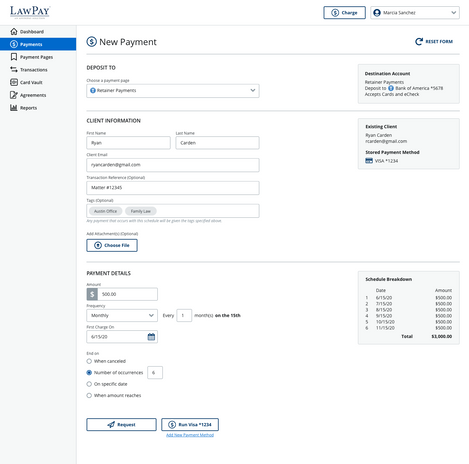Payments Reimagined
Crafting a Unified Payment Experience for Professionals
Payments are at the heart of every professional service. At AffiniPay, we recognized an opportunity to reshape how legal and accounting professionals get paid — simplifying a complex web of tools to create a unified, intuitive payment experience for LawPay, CPACharge, and AffiniPay for Associations.
Problem Statement
Over time, our flagship product LawPay grew into a patchwork of overlapping features: Quick Bill, VT Charge, Scheduled Payments, Payment Pages, API integrations, and mobile apps. With over $3.4B processed in 2020 across nine different payment tools, users struggled to decide which tool to use when, leading to confusion, inefficiency, and high support demand. The core question users repeatedly faced was simple yet critical
"Which feature should I use to get paid? 🤔"
So, we set out to simplify the experience and reduce the friction.
Role & Team
As Senior UX Designer, I led the UX strategy and vision for unifying this fragmented payment ecosystem. I collaborated closely with product managers, engineers, and customer support to align on goals and deliverables.
This project spanned several months in 2020–2021, leveraging tools such as Sketch/Figma and InVision for prototyping.
Research
Our research centered on extensive customer interviews and journey mapping to uncover real user behaviors and pain points. We discovered key use cases often unsupported, like adding surcharges, installment payments, custom fields, and reusable payment links. Importantly, users’ main actions boiled down to three intents: charging a card, sending a payment request, or setting up payment plans—either entering info themselves or letting clients enter it.
Our users were professionals in legal and accounting sectors, often juggling multiple payment tools and workflows. They valued compliance, flexibility, and efficiency in managing client payments.
User Journey / Experience Map
Mapping the payment journey revealed friction points where users were forced to make premature decisions about payment methods and tools, which didn’t align with their natural mental models. The complexity caused users to fall back on inefficient habits and increased errors.
We realized it wasn’t about lack of functionality. It was about simplifying the decision-making.
Ideation & Design Process
We crafted a vision for a single, flexible payment flow that eliminated upfront feature choices, instead centering on user intent.
Key concepts included:
-
Request vs. Run: Allowing users to decide whether to collect payment info themselves, run a charge immediately, or let clients enter info without choosing a specific feature first.
-
Custom Link Requests: Users could generate payment links for use in their own email workflows.
-
Card Vault Integration: Saving and reusing client payment info to speed processes and reduce errors.
-
Support for Attachments & Custom Fields: Enhancing payment requests with files and custom data, critical for complex legal billing.
-
New Payments Section: Consolidating all payment types into one accessible, cohesive interface.
Design, Prototyping & Testing
Hand Sketches
Explored early concepts for an intent-based payment flow. Quick drawings to visualize ideas and gather rapid feedback before committing to wireframes.
Final User Flow
Mapped every possible user path — from charging a card to sending a request or setting up a payment plan — to ensure flexibility within a single unified process.
Low-Fidelity Wireframes
Created grayscale layouts to define structure, content hierarchy, and core interactions without visual distractions.
High-Fidelity Mockups
Applied brand styling and scalable UI patterns to bring the unified flow to life. Incorporated real content for more accurate stakeholder reviews.
Final Solution
Although the complete "Payments Reimagined" flow wasn’t fully launched immediately, our work influenced major product milestones:
-
Launch of the Card Vault, now a cornerstone of the platform
-
Scheduling workflow improvements for recurring payments
-
The Unified Payment Flow release incorporating many proposed patterns
-
The 2025 LawPay Replatform and Redesign embracing our intent-based approach
Our concept became a strategic blueprint that shaped the platform’s long-term evolution.
Key Takeaways
This project reinforced that user understanding trumps feature parity. By shifting focus from building more tools to clarifying user intent, we created a scalable UX foundation with lasting impact. The initial vision planted seeds that continue to influence AffiniPay’s roadmap and product design culture.
Key takeaways for me:
-
Research can reframe questions, not just provide answers — shifting from “which feature to invest in?” to “why should users have to choose at all?” was a game changer.
-
Great design work can have a delayed but powerful impact across years.
-
Designing with longevity means building reusable patterns and a cohesive system, not one-off features.
Ultimately, I’m proud that this work contributed to AffiniPay being named one of CNBC’s Top Fintech Companies in the World, in the Payments category, alongside industry giants like Visa and Stripe, and received the G2 Award for Best Usability in the Best Legal Software Products Category.



















